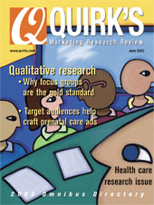Editor’s note: Dr. Murray Simon is president of D/R/S HealthCare Consultants, a pharmaceutical marketing research firm based in Charlotte, N.C.
There is a trend in pharmaceutical qualitative market research that seems to have evolved over the years, a trend toward the lengthy, all-inclusive discussion guide. What was once a two- or three-page document with lots of room for probing maneuverability is now typically a rather bloated seven-plus pages with every word of the pending interview spelled out. This development is quite understandable in light of the globalization of pharmaceutical products, the intense competitiveness of the marketplace and the escalating cost and complexity of successfully bringing a new drug to market but it does have its problems.
- In a focus group setting with multiple respondents it can lead to a series of short answers that lack the qualitative nuances that often prove so important in making strategic marketing decisions. Do the math - 20 or 30 questions for eight respondents over a 120-minute time span?
- With individual depth interviews, there is the risk of respondent fatigue or a steep drop-off in the level of interest. In evaluating a series of potential ad headlines, is it truly productive to ask, “How unique is this headline? / How relevant is it to you in your practice? / What is its inherent message? / What impact might it have on your decision to prescribe?”...and do that repeatedly for six or eight headlines? Why not a single question (with room for probing) that encompasses uniqueness, relevance, the inherent message and its potential impact for each headline?
- A bloated report is often the progeny of a bloated discussion guide; i.e., redundancy in the discussion guide often begets redundancy in the report.
- The process of having to verbally drag around an elephantine discussion guide during a week or two in the field can result in a brain-fried moderator - the same moderator who is now supposed to smoothly segue into analysis and report-writing mode.
- In report writing, there is the temptation to use tables and/or charts in an effort to manage and clarify lots of individual pieces of information. This can potentially lead to a false sense of statistical significance on the part of some clients.
Guidelines
Here are some guidelines to consider in developing that next discussion guide:
- Stay true to the objectives of the study: prioritize questions and distill out the nice-to-know from the need-to-know.
- Resist the temptation to put two or three market research projects into a one-project bucket.
- Encourage your moderator to play an active/aggressive role in developing and formatting the discussion guide.
- If the guide seems too long, it probably is. Seek out and eliminate redundancies.
- Run a pre-test to develop concise questioning and eliminate timing issues.
- Create an “if time permits” section at the end of the discussion guide for those questions that are somewhat less than essential but might add to the depth and richness of understanding.
- A critical component of any qualitative study for the moderator is to understand the objectives of the study and stay on course with those objectives throughout the project. The same holds true, of course, for the client.
